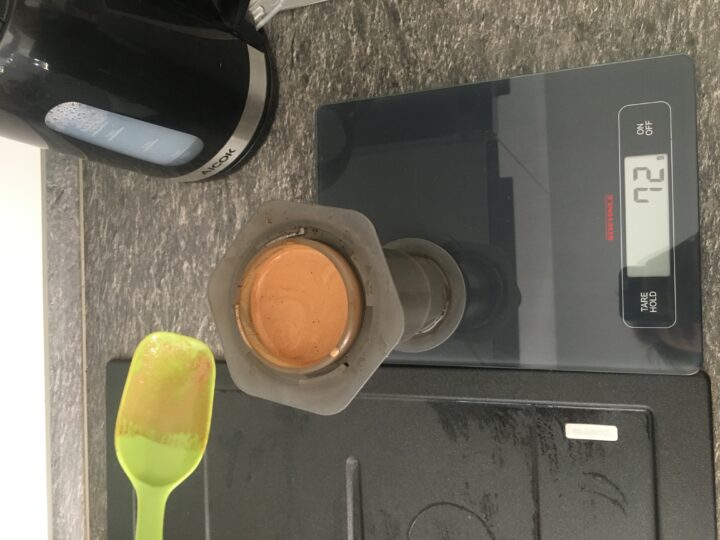Low-tech “mild coffee” with Aeropress

In this post, I present an Aeropress recipe that uses a “mild coffee” arabica roast (readily ground, no espresso) without the need of a scale or thermometer.
Motivation
Like many, often times I like to grind my coffee, use a fresh roast and engage a scale and a thermometer in the process. So all in all a rather high-tech approach. Sometimes the equipment is not on hand, e.g. when traveling or staying in another place. For that, I need a low-tech way of coffee making. As a bonus, searching for the fundamentals in coffee brewing is fun and sharpens the understanding of the underlying processes.
The problem with low water temperature
Lot of places recommend water temperature ranging from 90 °C – 93 °C e.g. here. The inventor or Aeropress is even promoting temperatures as low as 80 °C. But using low temperatures, leaves me with two problems:
- You need to measure the water temperature (equipment at hand needed)
- When using “mild” arabica coffee roasts that where readily ground, I got sour tasting coffee
Fixing sour coffee
I tried longer brewing times (2 min instead of 1 min 30 sec). But that was leaving me with over-extracted results, rather than fixing the imbalance in taste profile, I was looking for.
Increasing the temperature to almost boiling hot, however, has fixed the problem. After some experimentation, I’ve been getting nicely balanced, and actually mild coffees. And as a side effect, I got rid of the necessity of a thermometer.
The trick is, to fill a certain amount of water in the kettle, and wait a certain time span after the kettle switches off after boiling. That assures temperature consistency. Of course the result varies from kettle to kettle, but that can be dialed in by adjusting the time span of cool down. In order to limit the waiting times, two things come to mind:
- Only use little water in the boiler (needs less time to boil and cools down faster afterwards). The amount of the desired coffee volume, plus a little for rising the filter will do.
- Make use of the different temperatures and heat capacities of water and grounds: Use only little water in the brewing process and add water later up to the desired coffee volume (bypass method). As a result, the grounds absorb a lot of the waters thermal energy on contact, reducing the heat almost instantaneously. This enables us to use almost boiling water, but at the same time assures, that the temperature of the coffee slurry doesn’t end up too high (we are looking for e.g. 89 °C – 93 °C, as coffee expert Scott Rao recommends for filter coffee here)
Bem vindo! “Mild coffee”, low-tech
- brew ratio 1:12,5 (16 g of grounds, 200 ml final coffee volume)
- high water temperature (99 °C – 98 °C)
- bypass method (a small volume of coffee with high brew strength gets diluted afterwards by adding water)
We won’t need a thermometer. To also make a scale obsolete, I like to use body measures (my palm for measuring the amount of grounds) and a glass or mug where I know the volume it can hold.
Walk though: The step-by-step guide
- pull out the plunger of the Aeropress in between marking No. 1 and 2
- use two palm full of grounds (16 g with my palm, check your body measurements with a scale and adjust recipe accordingly)
- pour two glasses of water in the kettle (I use the 200 ml glass, I’m gonna brew the coffee in)
- start a timer the moment when the kettles boiling switch releases. Cool down starts
- Rinse the filter in the meantime, to avoid taste of paper to the coffee.
- after 30 sec, cool down is finished. Pour water to the Aeropress until full (about 65 ml)
- Now a 1 min 30 sec brewing sequence follows
- Wait 20 sec for blooming (the grounds get soaked and ready for extraction)
- Stir 20 sec (accelerates the extraction and makes it more uniform)
- Let sit for 30 sec (additional extraction)
- Slowly press the plunger, aiming for a 20 sec time period until completion
- The extraction is done. Timer shows 2 minutes. About 50 ml of coffee extract are in the glass.
- Lastly, dilute the extract by adding water until the glas is full. Bem vindo! 200 ml of mild coffee are extracted.






